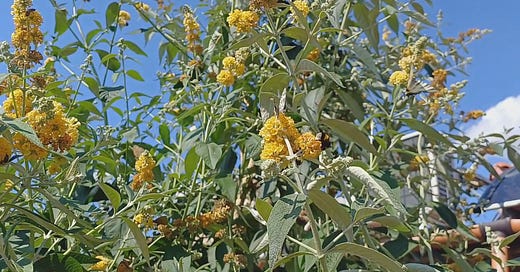The butterflies in my garden give me so much joy, I want to share it with you, especially if you don’t have access to nature or not much joy in your life right now.
I’ve filmed butterflies in my garden this week. This isn’t about writing and books, it’s just about butterflies. I hope the video puts a smile in your heart.
There are thousands of butterflies (American English: my yard), of many different varieties. Plus many bees, bumblebees and other beneficial insects.
I've used my own plot of land (and an abandoned neighbouring plot) her ein Bulgaria to create an eco project: permaculture, organic gardening, no pesticides, lots of plants for pollinating insects. There have always been bees and butterflies, but the number is increasing year by year, and five years after I've started, the sheer number is staggering.
If you want to attract butterflies to your garden, here are four tips:
1. Don't use pesticides.The chemicals that kill aphids and mosquitoes also kill butterflies and bees. You don't need that nasty stuff (although the chemical industry tries to brainwash us that we do.
2. Plant flowers which provide nectar for bees and butterflies. Generally, what's good for bees is at the same time good for butterflies. Especially good, and very suitable for Bulgarian climate: buddleia, lavender, marjoram, tagetes, verbena bonariensis. If you offer many unpoisoned flowers with delicious nectar, the bees and butterflies will flock to your garden instead of the chemical-poisoned agricultural fields.
3. If you want to go a step further, also provide host plants for the caterpillars. Different butterflies prefer different host plants for laying their eggs, so it can be complicated if you want to provide for them all, but nettles are a good for many kinds. A general mix of plants in the vicinity is also good (maybe there's an overgrown thicket nearby) where there's food for all kinds of caterpillars. (Note: some caterpillars also eat vegetables and can really damage your harvest. But most prefer nettles, thistles, the leaves of the black locust tree and such.)
4. If you're serious about supporting butterflies, provide a wind-sheltered area. Plant trees and hedges which serve as windbreaks.
Disclaimer: I'm not a butterfly expert. My expertise is plants and organic gardening. :-)
If you don’t have a garden, and can’t enjoy butterflies in nature, then I hope that this video has given you a ‘virtual’ nature experience.
Best wishes,
Rayne




Share this post